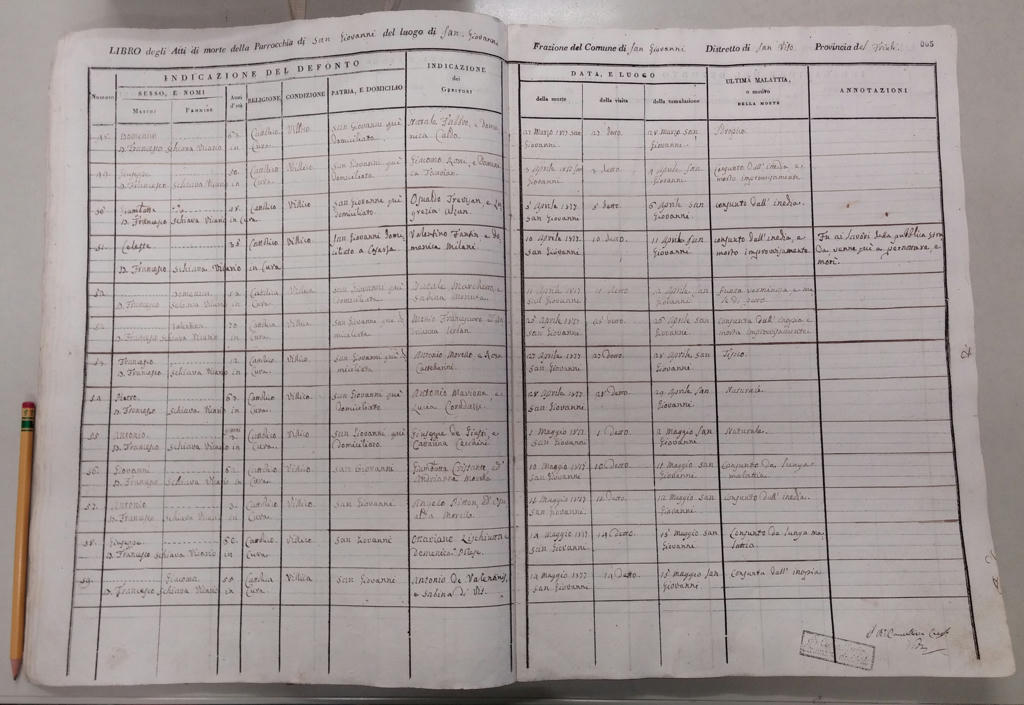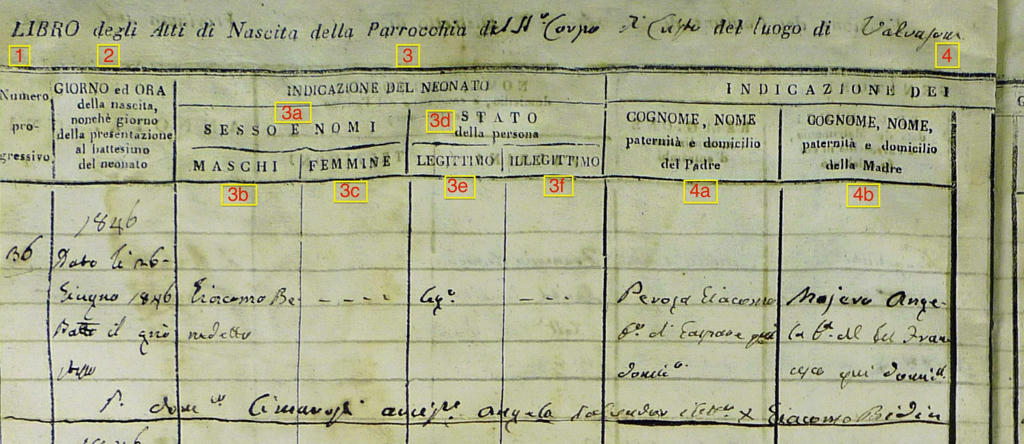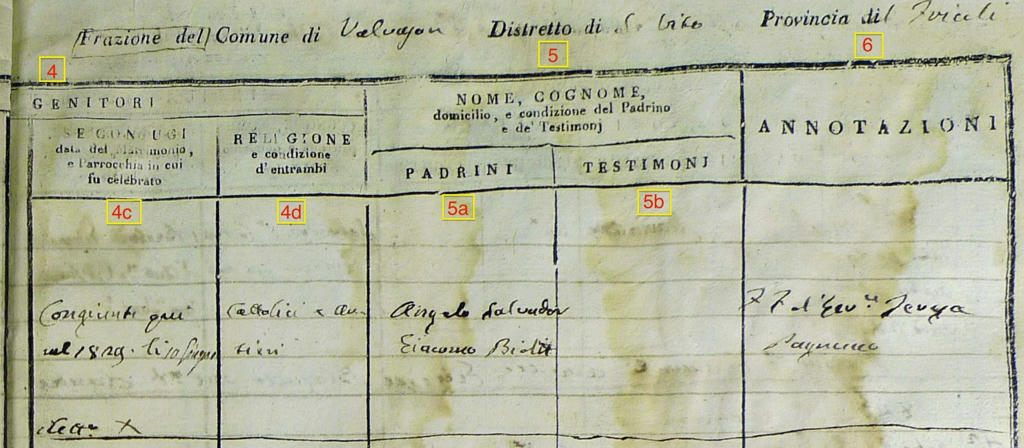Provinces of the Kingdom (wikipedia)
The most important thing to notice is that, because they were pre-printed and the priest (or an assistant) had to simply fill in the text following the headers’ instructions, these records usually have lots more informations than those equivalent in the Church books.
If you’re looking for births, deaths or marriages that occurred during this period (and in these regions), always think to look in these registers first, if they still exist. If they don’t, then try with the church books.
This is a picture I’ve taken of one of these big books, with a normal-sized pencil on the left, for scale.
The registrations span both pages, the rows are usually divided by lines but not always.
They are kept by the parish or by the competent Diocesan Archive.
Parrocchia di San Giovanni di Casarsa, Registro Morti, 1816-1842 sep. 23, pages 4-5, Diocesi di Concordia-Pordenone, Archivio Storico, Pordenone
These books have different column headers depending on what they were for, but all of them had this text on top of the pages:
Libro degli Atti di Morte [or Nascita, or Matrimonio] della parrocchia di [blank] del luogo di [blank] Frazione del comune di [blank] Distretto di [blank] Provincia [blank]
Book of Death Certificates [or Birth, or Marriages] for the parish of [blank] in [blank] Hamlet of the Commune of [blank] District of [blank] Province [blank]
Today I’m going to explain and translate the column headings for the births.
Let’s start with page left:
Look at the page and then refer to the red numbers and letters I’ve written:
Parrocchia di Valvasone, Libro dei Nati 1846-1853, page 39, n. 36, digital copy, Diocesi di Concordia-Pordenone, Archivio Storico, Pordenone
Italian:
1 - Numero progressivo
2 - Giorno ed ora della nascita, nonché giorno della presentazione al battesimo del neonato
3 - Indicazioni del neonato
3a - Sesso e nomi
3b - Maschi
3c - Femmine
3d - Stato della persona
3e - Legittimo
3f - Illegittimo
4 - Indicazioni dei Genitori (continues right page)
4a - Cognome, Nome, paternità e domicilio del Padre
4b - Cognome, Nome, paternità e domicilio della Madre
English:
1 - Progressive number
2 - Day and time of the birth, as well as day of the baptism of the baby
3 - Informations about the baby
3a - sex and names
3b - Males
3c - Females
3d - Condition of the person
3e - Legitimate
3f - Illegitimate
4 - Informations about the parents (continues on the right page)
4a - Surname, Name, Paternity and domicile of the Father
4b - Surname, Name, Paternity and domicile of the Mother
NB: In earlier books it's possible that 4a and 4b are switched, so you'll find the mother mentioned first while the father is on the next column.
If you look at the baby born in that page at number 36, this is his birth info (page left only)
Number 36 - 26th June 1846, bapt. same day, Giacomo Benedetto, legitimate, son of Perosa Giacomo son of Gaspare, living here [Valvasone], and of Majero Angela daughter of the deceased Francesco, living here.
[Perosa is the surname, Giacomo Benedetto is first and middle name.]
NB: Sometimes in the column for the baby's name (3b or 3c depending on the sex) they also repeat the surname, otherwise you infer it from the father's column.
Unless the person writing was lazy or didn’t know, we should always find the mothers’ maiden names and the names of paternal and maternal grandfathers.
Now let’s look at the right page and do the same:
Parrocchia di Valvasone, Libro dei Nati 1846-1853, page 40, n. 36, digital copy, Diocesi di Concordia-Pordenone, Archivio Storico, Pordenone
Italian:4 - Indicazione dei genitori (continues from left page)
4c - Se coniugi data dei Matrimonio, e parrocchia in cui fu celebrato
4d - Religione e condizione di entrambi
5 - Nome, Cognome, domicilio, e condizione del Padrino e de’ Testimonj
5a - Padrini
5b - Testimonj
6 - Annotazioni
English:
4 - Informations about the parents (continuing from the left page)
4c - If married, date and parish of marriage
4d - Religion and condition of both
5 - Name, Surname, domicile and condition of Godfather and Witnesses
5a - Godfathers
5b - Witnesses
6 - Notes
Continuing with n. 36, Giacomo Benedetto’s birth, his parents were married in that same parish (of Valvasone) on the 10th of June 1829, were Catholics and [can’t make out their profession]. Godfathers were Angelo Salvador and Giacomo Biotti, in the notes column the name of the midwife, Teresa Pagnacco, is recorded.
Notice that this writer did not follow the instructions literally, as he neglected to mention the godfather’s condition and domicile, and there were no witnesses.
Sometimes in the notes column you'll find interesting speculations or reports about the baby's paternity, especially when he/she was illegitimate, or when the dates of marriage of the parents were too close to the birth. In other cases it was recorded that the midwife had already baptized the newborn because she felt he/she was going to die and there wasn't time to call a priest.
I hope this is clear!
Next blog post: Marriages




This is a wonderful discovery. I'm a genealogist who does speak, read and write Italian but live in Canada. My parents were both from Friuli (Pordenone area and Udine area). I can access records from 1871-1910 online and some records from 1806-1815 but have no access to information for the 1815-1870 period. It's very frustrating. Do you know of anyone who can undertake some research for me in Italy or if there is a way to access these records online anywhere? I look forward to hearing from you. Sandra Pagotto Moffatt
ReplyDelete